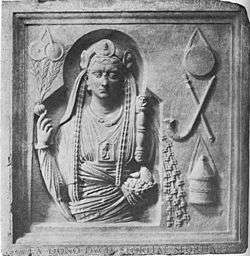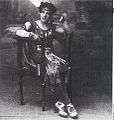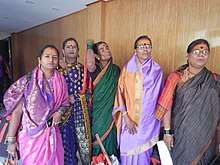Transvestism
Transvestism is the practice of dressing in a style or manner traditionally associated with the opposite sex. In some cultures, transvestism is practiced for religious, traditional, or ceremonial reasons.[1]
| Cross-dressing |
|---|
|
|
Key elements |
|
Modern drag culture |
|
Sexual aspects
|
|
Other aspects |
|
Passing as male |
|
Passing as female
|
|
Books
|
_-_n._0923_-_da_-_Amore_e_arte%2C_p._32.jpg)
History
Terminology
Though the term was coined as late as the 1910s, the phenomenon is not new. It was referred to in the Hebrew Bible.[2] The word has undergone several changes of meaning since it was first coined and is still used in a variety of senses. Today, the term transvestite is commonly considered outdated and derogatory, with the term cross-dresser used as a more appropriate replacement.[3][4][5] This is because the term transvestite was historically used to diagnose medical disorders, including mental health disorders, and transvestism was viewed as a disorder, but the term cross-dresser was coined by the transgender community.[3][6] In some cases, however, the term transvestite is seen as more appropriate for use by members of the transgender community instead of by those outside of the transgender community, and some have reclaimed the word.[7][8]
Origin of the term
Magnus Hirschfeld coined the word transvestite in 1910 (from Latin trans-, "across, over" and vestitus, "dressed") to refer to the sexual interest in cross-dressing.[9] He used it to describe persons who habitually and voluntarily wore clothes of the opposite sex. Hirschfeld's group of transvestites consisted of both males and females, with heterosexual, homosexual, bisexual, and asexual orientations.[10]
Hirschfeld himself was not happy with the term: He believed that clothing was only an outward symbol chosen on the basis of various internal psychological situations.[9] In fact, Hirschfeld helped people to achieve the very first name changes (legal given names were and are required to be gender-specific in Germany) and performed the first reported sexual reassignment surgery. Hirschfeld's transvestites therefore were, in today's terms, not only transvestites, but a variety of people from the transgender spectrum.[9]
Hirschfeld also noticed that sexual arousal was often associated with transvestism.[9] In more recent terminology, this is sometimes called transvestic fetishism.[11] Hirschfeld also clearly distinguished between transvestism as an expression of a person's "contra-sexual" (transgender) feelings and fetishistic behavior, even if the latter involved wearing clothes of the other sex.[9]
Cross-dressers

One of the fiercest activists to come out of the Stonewall Riots was Sylvia Rivera, who set up Street Transvestite Action Revolutionaries. In a 1971 essay, "Transvestites: Your Half Sisters and Half Brothers of the Revolution", Rivera wrote, "Transvestites are homosexual men and women who dress in clothes of the opposite sex."[12]
After all the changes that took place during the 1970s, a large group was left without a word to describe themselves: heterosexual males who wear traditionally feminine clothing. This group was not particularly happy with the term "transvestism", and therefore took on the term "cross-dresser".[13] Cross-dressers are men who wear female clothing and often both admire and imitate women, but self-identify as different from both gay men and transsexuals, and generally deny having fetishistic intentions.
When cross-dressing occurs for erotic purposes over a period of at least six months and also causes significant distress or impairment, the behavior is considered a mental disorder in the Diagnostic and Statistical Manual of Mental Disorders, and the psychiatric diagnosis "transvestic fetishism" is applied.[14]
Culture
In some cultures, transvestism is practiced for religious, traditional or ceremonial reasons. For example, in India some male devotees of the Hindu god Krishna, especially in Mathura and Vrindavan, dress in female attire to pose as his consort, the goddess Radha, as an act of devotion.[15] In Italy, the Neapolitan femminielli wear wedding dresses, called the matrimonio dei femminielli (marriage of the feminine males), a procession takes place through the streets, a tradition that apparently has pagan origins.[16]
Image gallery
 Priest/priestess Archigallus of ancient Rome.
Priest/priestess Archigallus of ancient Rome. A 1927 photograph of Álvaro Echavarría ("El excluido") of Cúcuta, Colombia
A 1927 photograph of Álvaro Echavarría ("El excluido") of Cúcuta, Colombia.jpg) Baron von Teschenberg, a German transvestite, one of the founders of the Scientific-Humanitarian Committee
Baron von Teschenberg, a German transvestite, one of the founders of the Scientific-Humanitarian Committee.jpg) A modern American transvestite.
A modern American transvestite. A 19th-century photograph of a femminiello, an ancient culture of cross dressing in Naples, Italy
A 19th-century photograph of a femminiello, an ancient culture of cross dressing in Naples, Italy A gay man and a transvestite kissing in a demonstration, Mexico City
A gay man and a transvestite kissing in a demonstration, Mexico City.jpg) Conchita Wurst holding the Eurovision trophy after winning the contest
Conchita Wurst holding the Eurovision trophy after winning the contest
See also
- Drag (clothing)
- List of transgender-related topics
- Transsexual
- Travesti (theatre)
- Dual-role transvestism
Notes
- Eric H. Boehm; Historical Abstracts: Modern history abstracts, 1775-1914, Volume 50, Edition 3 - page: 723
- Aggrawal, Anil. (April 2009). "References to the paraphilias and sexual crimes in the Bible". J Forensic Leg Med. 16 (3): 109–14. doi:10.1016/j.jflm.2008.07.006. PMID 19239958.
- Annemarie Vaccaro, Gerri August, Megan S. Kennedy (2011). Safe Spaces: Making Schools and Communities Welcoming to LGBT Youth. ABC-CLIO. p. 142. ISBN 978-0313393686. Retrieved October 21, 2016.
Cross-dresser/cross-dressing. (1) The most neutral word to describe a person who dresses, at least partially or part of the time, and for any number of reasons, in clothing associated with another gender within a particular society. Carries no implications of 'usual' gender appearance, or sexual orientation. Has replaced transvestite, which is outdated, problematic, and generally offensive since it was historically used to diagnose medical/mental health disorders.
CS1 maint: uses authors parameter (link) - Jamie C. Capuzza, Leland G. Spencer (2015). Transgender Communication Studies: Histories, Trends, and Trajectories. Lexington Books. p. 174. ISBN 978-1498500067. Retrieved October 21, 2016.
Eventually, the transvestite label fell out of favor because it was deemed to be derogatory; cross-dresser has emerged as a more suitable replacement (GLAAD, 2014b).
CS1 maint: uses authors parameter (link) - Charles Zastrow (2016). Empowerment Series: Introduction to Social Work and Social Welfare: Empowering People. Cengage Learning. p. 239. ISBN 978-1305388338. Retrieved October 21, 2016.
The term transvestite is often considered an offensive term.
CS1 maint: uses authors parameter (link) - David A. Gerstner (2006). Routledge International Encyclopedia of Queer Culture. Routledge. p. 568. ISBN 0313393680. Retrieved October 21, 2016.
A variety of derogatory terms are still used to describe any aspect of the transgender condition. [...] The term transvestite being older [than cross-dresser] and associated with the medical community's negative view of the practice, has come to be seen as a derogatory term. [...] The term cross-dresser, in contrast, having come from the transgender community itself, is a term seen as not possessing these negative connotations.
- Laura Castañeda (2006). News and Sexuality: Media Portraits of Diversity. Sage Publications. p. 129. ISBN 1412909996. Retrieved October 21, 2016.
Trannie is a word much like fag or nigger. It may be permitted in conversation between members of the same group but it is deemed an insult when applied to a transsexual by someone who is not transsexual. Transvestite is deemed a derogatory term when applied to a transsexual. Indiscriminate use of these three words, along with the others, shows a lack of training in and understanding of minority relations.
- Christina Richards, Meg Barker (2006). Sexuality and Gender for Mental Health Professionals: A Practical Guide. Sage Publications. p. 162. ISBN 1446287165. Retrieved October 21, 2016.
The term transvestite should not be considered to be a safe term, and should certainly not be used as a noun, as in 'a transvestite'. Instead, and only when relevant, the term trans person should be used. [...] There are some people who have reclaimed the word transvestite and may also use the word tranny or TV to refer to themselves and others. [...] The term cross-dressing too is somewhat outdated and problematic as not only do many fashions allow any gender to wear them -- at least in many contemporary Western societies -- but it also suggests a strict dichotomy being reinforced by the person who uses it.
CS1 maint: uses authors parameter (link) - Hirschfeld, Magnus: Die Transvestiten. Berlin 1910: Alfred Pulvermacher
Hirschfeld, Magnus. (1910/1991). Transvestites: The erotic drive to cross dress. (M. A. Lombardi-Nash, Trans.) Buffalo, NY: Prometheus Books. - Hirschfeld, Magnus. Geschlechtsverirrungen, 10th Ed. 1992, page 142 ff.
- American Psychiatric Association (2013). Diagnostic and Statistical Manual of Mental Disorders: DSM-5 (Fifth ed.). Arlington, Virginia: American Psychiatric Publishing. pp. 685–705. ISBN 978-0-89042-555-8. OCLC 847226928.
- Rivera, Sylvia, "Transvestites: Your Half Sisters and Half Brothers of the Revolution" in Street Transvestite Action Revolutionaries: Survival, Revolt, and Queer Antagonist Struggle. Untorelli Press, 2013. "Transvestites are homosexual men and women who dress in clothes of the opposite sex."
- Bullough, Vern L. Cross Dressing, Sex, and Gender. University of Pennsylvania Press, 1993. ISBN 0812214315
- "DSM-V" (PDF). The DSM Diagnostic Criteria for Transvestic Fetishism. American Psychiatric Association. 2009. Retrieved February 4, 2013.
- Meet the crossdresser saints of UP. CNN-IBN. Retrieved 21 January 2013
- Il mondo del "femminiello", cultura e tradizione. TorreSette.it. Retrieved 21 January 2013
References
- Ackroyd, Peter. Dressing up, transvestism and drag: the history of an obsession. Simon and Schuster, 1979. ISBN 0671250914
- Mancini, Elena. A Brighter Shade of Pink: Magnus Hirschfeld. ProQuest, 2007. ISBN 0549700552
- Ambrosio, Giovanna. Transvestism, Transsexualism in the Psychoanalytic Dimension. Karnac Books, 2011. ISBN 178049307X
- Gravois, Valory. Cherry Single: A Transvestite Comes of Age (a novel) Alchemist/Light Publishing, 1997 (Available to read free, online), ISBN 0-9600650-5-9
Further reading
- Thanem Torkild, Wallenberg Louise (2016). "Just doing gender? Transvestism and the power of underdoing gender in everyday life and work". Organization. 23 (2): 250–271. doi:10.1177/1350508414547559.
External links
| Wikimedia Commons has media related to Transvestism. |
![]()
